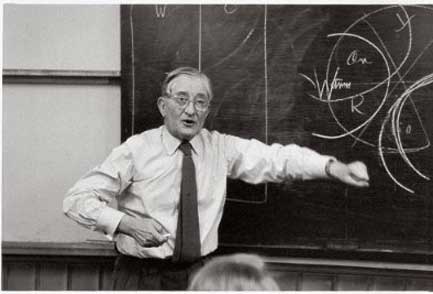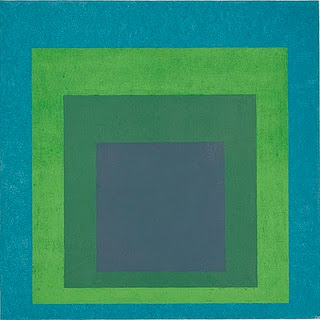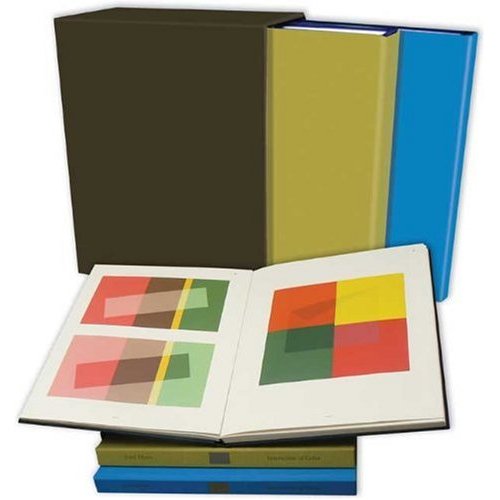“…like Picasso has said it, “We don’t get what we want.” And therefore we continue, and therefore my saying is, “A painter paints because he has no time not to paint.”
— Joseph Albers
Albers, Josef, b. 1888 d. 1976, was one of the most influential artist-educators of the 20th century, was a member of the Bauhaus group in Germany during the 1920s. In 1933 he came to the United States, where he taught at Black Mountain College for sixteen years. In 1950 he joined the faculty at Yale University as chairman of the Department of Design and was professor emeritus of art at Yale until his death in 1976. Joseph Albers was a significant contributor and influence on modern painting.
From his wikipedia page…”Accomplished as a designer, photographer, typographer, printmaker and poet, Albers is best remembered for his work as an abstract painter and theorist. He favored a very disciplined approach to composition. Most famous of all are the hundreds of paintings and prints that make up the series Homage to the Square. In this rigorous series, begun in 1949, Albers explored chromatic interactions with flat colored squares arranged concentrically. Painting usually on Masonite, he used a palette knife with oil colors and often recorded colors used on the back of his works.”
Albers is perhaps best known today by art students for his famous book and course of study Interaction of Color Originally issued in 1963 as a limited-edition set of commentary and 150 silkscreened colour plates, the book introduced generations of students, artists, designers, and collectors to Albers’ unique approach to complex principles. A smaller version of the Interaction of Color was published later (1975) and has been a mainstay color bible for generations of art students.
The original publication has long been out of print and is extremely expensive if you could find it at all. However the original silkscreened printing likely have the greatest color fidelity. A the January 2010 reissue of Interaction of Color: New Complete Edition [Hardcover] is considered by many reviewers on Amazon to be a gorgeous book. From the publisher’s blurb… “Lavishly produced as a two-volume slipcased set, this book replicates Albers’ revolutionary exercises, explaining concepts such as colour relativity and vibrating and vanishing boundaries through the use of colour, shape, die-cut forms, and movable flaps that illustrate his astonishing demonstrations of the changing and relative nature of colour. Also included for the first time are new studies from the Albers archive, produced by the artist’s students in the early 1960s. A celebration of Albers’ legendary achievements, this beautiful publication is an essential addition to any serious art library.”
in a shameless promotion, I’m linking this book to Amazon where a small percentage of the sale goes to help support this site if you click from this link…
Interaction of Color: New Complete Edition
There is also an interesting new biography,Josef Albers: To Open Eyes you may want to consider.
A very interesting video from one of Albers former students (note he has several more related videos on Albers Color Theory for viewing on Vimeo)
Albers Homage To The Square: An Explanation from Richard (Dick) Nelson on Vimeo
A few excerpts from a long interview with Josef Albers from the Archives of American Art Smithsonian Institute Oral history interview in 1968
Complete interview can be read from this Archives of American Art, Smithsonian Institution link
JOSEF ALBERS:
And why do I paint squares since 1959, in the same design, in the same arrangement; Because I do not see that there is, in any visual articulation, one final solution. In science they think sometimes they have found a solution. Already the next year the whole thing may look upside down, and its not the truth any more. An example I have quoted repeatedly: in 1848 I think it was, (it was at that time when flying was considered an insoluble problem) that was a time when the chemists at an international congress agreed that we are not able to develop an organic compound from inorganic constituents. And in the next year, in 1849, Boettcher was able to develop an organic compound urea, you see. So, in science what seems true today may not be true tomorrow. There science is dealing with physical facts, in art we are dealing with psychic effects. With this I come to my first statement: The source of art – that is, where it comes from – is the discrepancy between physical fact and psychic effect. That’s what I’m talking about. When I want to speak about why I am doing the same thing now, which is squares, for – how long? – 19 years. Because there is no final solution in any visual formulation. Although this may be just a belief on my part, I have some assurances that that is not the most stupid thing to do, through Cezanne, whom I consider as one of the greatest painters. From Cezanne we have, so the historians tell us – 250 paintings of Mont St. Victoire. But we know that Cezanne has left in the fields often more than he took home because he was disappointed with his work. So we may conclude he did many more than 250 of the same problem. Yes?
SEVIM FESCI: Yes.
JOSEF ALBERS: How see Van Gogh. You know his Sunflowers?
SEVIM FESCI: Yes, of course.
JOSEF ALBERS: He has traced them on tracing paper and then has transferred the tracings on new canvases, precisely the same shape. Every flower and leaf form is repeated precisely. This mad man undertook a method to save time and traced and transferred it on another canvas again and again, and filled out the contours with other colors. So we have multiplied sunflowers – I have photographed them, I have slides on it that prove that he made the same contour of sunflowers in other colors. We have two l’Arlesiennes. Why two? Because he was not satisfied with the first one. He said there is another possibility, you see. And that is what Picasso has said this way, I quote now, “When we are honest we have to admit that we never get what we want.” So I am excused when I make now several hundred squares. Yes? Or when you go downstairs and see – I am now in my red period. I was for years in the yellow period, you know. But now I am with the reds, it was hard for me to get into the reds. Very hard, how I am tickled to death to make more reds. Which one is the best I don’t know. But this is to show why I am promoting serial image. Because like Cezanne has demonstrated it, like Picasso has said it, “We don’t get what we want.” And therefore we continue, and therefore my saying is, “A painter paints because he has no time not to paint.” And I am a teacher because I teach all the time – now you are my victim – I teach and I have no time not to teach. And I’m a little bit disturbed when I have to play retrospective, as I did before. You see that I’ve changed my viewpoint
JOSEF ALBERS: I understand. But, you see, I am more interested to stimulate the creative process. In my basic courses I have always tried to develop discovery and invention which, in my opinion, are the criteria of creativeness. I have tried to make people aware and ready to recognize – that’s again observation, the word I used before, and in articulation what is then the reaction to it. The creative process as such I have tried to lead back to the most basic attitude, and that is by presenting, and there I feel very instrumental, by presenting to my students material as such without telling them what to do, how to handle it, but ask them to find a new —
SEVIM FESCI: Way of expressing.
JOSEF ALBERS: No, not the word “expression” – I have told you already that’s not —
SEVIM FESCI: Of presenting them?
JOSEF ALBERS: — to find out what it is able to do, by presenting it with a new function. Therefore, I came furthermore to the conclusion just at the end of my formal teaching – I usually say I taught for a hundred years – that all art studies are in the end basic and that at art schools there are no graduate studies. The graduate studies come when they leave the school and are working their whole life and demonstrate that also in other fields. Graduate students don’t want to be led by professors. They want to find their own “nonsense”. So I have come to the conclusion that the graduate art school is an error. And I have experienced that in another way, also, When I was called to Yale Art School here I was expected to teach mainly the older – graduate students. But I made a point that I took first and mostly the beginners because the babies need more education than the grownups. And so the students out of the graduate class came into my basic courses without being asked to do that. Therefore I had such large classes in the basic courses in color and in drawing and later also when I gave basic design again. I’m very rough in the treating of my students. And in saying it now, I have said to my students “I am putting you into a vacuum and ask you to breathe.” But at the school we came to new discoveries, to new formulations, and that, I think, has been followed up more or less everywhere in the world.


JOSEF ALBERS: Well, I would say the aim of art is a constant, and a continuous job to reveal visually the attitude of our mentality. And the less we disturb the influence of our mentality the more I believe we come close to the truth. And therefore the last 15-20 years in which everyone tried to be different from everyone else with the result that in their work, they all look alike, there is an artificial and not true relationship because honesty and modesty are forgotten. The more eccentric one behaved the more he was considered a personality. On the other hand, the, more you obey your constitutional inclinations, your constitutional preferences and prejudices, the more you are yourself. You have not to force so-called individuality. You have to avoid everything that makes you a Wagnerian blowing up your gestures, blowing up your verbal formulations. Therefore I recommend simplicity because it is honest against all over-dramatization.
More great information and imagery can be found on the Albers Foundation website






Leave a Reply